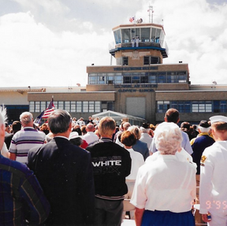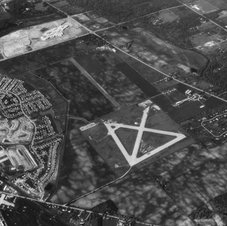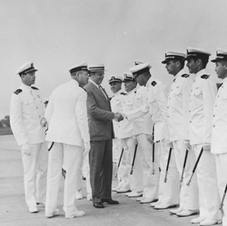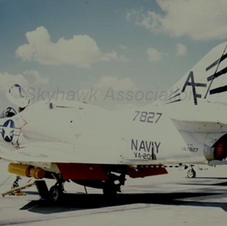Naval Air Station Glenview
Naval Air Station Glenview (NASG)
For more details about NASG, visit HangarOneFoundation. The public is invited to visit the Naval Air Station Museum located at 2040 Lehigh Avenue in Glenview. The museum is open Saturday and Sunday from 1:00 to 4:00 PM. Phone: 847-657-0000
Curtiss Air Field
The base, dedicated as Curtiss Field on October 20, 1929, was originally built by the Curtiss Flying Service to be the hub of Chicago's air service. When the field was dedicated as Curtiss Field on October 20, 1929, Curtiss Field featured the largest and most innovative hanger of its time, Hangar One. It was built at a cost of approximately $3 million (about $44.8 million in today's money). It was considered one of the finest airports in the Midwest.
U.S. Navy
Between World War I and World War II, the U.S. Navy established a series of Naval Reserve Air Bases where reservists initially flew and maintained seaplane from shore facilities on Lake Michigan and a small facility at the Naval Training Station Great Lakes. To accommodate newer and larger aircraft enter the Fleet in the 1930s, the NRAB was relocated to Curtiss-Reynolds Airport/Curtiss Field. The official dedication as NRAB Chicago was August 18, 1937.
August 28, 1937
Formal Commission Ceremonies
Formal commission ceremonies were held as Naval Reserve Aviation Base Chicago moved to Glenview, leasing most of the hangar at Curtis-Reynolds Airport. 26,000 attended the dedication. (Photo: Assistant Secretary of the Navy, center, attended the ceremonies)

Naval Air Station Glenview (NASG)
For more details about NASG, visit HangarOneFoundation. The public is invited to visit the Naval Air Station Museum located at 2040 Lehigh Avenue in Glenview. The museum is open Saturday and Sunday from 1:00 to 4:00 PM. Phone: 847-657-0000
Curtiss Air Field
The base, dedicated as Curtiss Field on October 20, 1929, was originally built by the Curtiss Flying Service to be the hub of Chicago's air service. When the field was dedicated as Curtiss Field on October 20, 1929, Curtiss Field featured the largest and most innovative hanger of its time, Hangar One. It was built at a cost of approximately $3 million (about $44.8 million in today's money). It was considered one of the finest airports in the Midwest.
U.S. Navy
Between World War I and World War II, the U.S. Navy established a series of Naval Reserve Air Bases where reservists initially flew and maintained seaplane from shore facilities on Lake Michigan and a small facility at the Naval Training Station Great Lakes. To accommodate newer and larger aircraft enter the Fleet in the 1930s, the NRAB was relocated to Curtiss-Reynolds Airport/Curtiss Field. The official dedication as NRAB Chicago was August 18, 1937.
Preparing for War
For the next three years, the air station's primary role was elimination training for students seeking appointments as Naval Aviation Cadets (NAVCADs).
By 1941, with the United States' entry into World War II appearing imminent, NRAB Chicago became the first base (of several bases across the country) in a new program to provide primary flight training. To accommodate this new purpose, in 121 work days, 1,300,000 square feet of new concrete was poured for runways, taxiways and ramps. New hangars and other administrative and support buildings were constructed and completed by late November 1942. On 1 January 1943, NRAB Chicago was redesignated as NAS Chicago. By 1944, "Chicago" was deleted from the air station's title and the installation renamed NAS Glenview.
Wartime Training
Nearly 9,000 aviation cadets for the U.S. Navy, U.S. Marine Corps and U.S. Coast Guard received their primary flight training at NAS Glenview during World War II, which represented over 800,000 flight hours and over 2 million takeoffs and landings. Later during the war, NAS Glenview also hosted advanced training in Fleet combat aircraft, primarily for carrier qualification in Lake Michigan aboard the Chicago-homeported training aircraft carriers.
Post-World War II through the Cold War Era
Following the end of World War II, NAS Glenview discontinued its role as a primary training base and became headquarters for the newly formed Naval and Marine Reserve AviationTraining Command in 1946. In addition, NAS Glenview was involved in a wide range of activity. For more information
Base Realignment and Closure (BRAC)
Towards the end and following the end of the Cold War, BRAC Commissions were established to shed what the Department of Defense and the U.S. Congress considered to be excess military units and infrastructure. The 1993 BRAC identified NAS Glenview for closure no later than September 30, 1995, along with corresponding inactivation or transfer of its assigned squadrons and other units.
August 15, 1971
Attack Squadron VA 209 Decommissioned
With the reorganization of the Naval Reserves in 1970, most units at Naval Air Station Glenview were decommissioned. The last Navy Squadron to go – Attack Squadron VA 209 – on this day closed out 48 years of Naval Reserve Attack Aviation in the Chicago area.


AJuly 16, 1951
GNAS Expansion
Work began on a $2.7 million expansion of the Naval Air Station Glenview to equip it as a training base for jet aircraft, which included lengthening the runway, installing high-intensity runway lights and adding two new jet plane fuel tanks. (Photo: aerial view, June 1951)
Naval Air Station Glenview (NASG)
Base Realignment and Closure (BRAC)
Towards the end and following the end of the Cold War, BRAC Commissions were established to shed what the Department of Defense and the U.S. Congress considered to be excess military units and infrastructure. The 1993 BRAC identified NAS Glenview for closure no later than September 30, 1995, along with corresponding inactivation or transfer of its assigned squadrons and other units.

September 9, 1995
Closure ceremony for NASG
September 9, 1995 - A closure ceremony for Naval Air Station Glenview was held, attended by 1,700 people – military and civilian. The ceremony closed the log on the base and it was officially decommissioned September 30.

June 29, 1998
U.S. Navy transfers the Naval Air Station Glenview
On June 29, 1998, the Navy transferred the last segment of the closed Naval Air Station Glenview from Navy ownership to private ownership, with the Village of Glenview, Illinois and the Local Reuse Authority (LRA) taking possession of over 90% of the closed and transferring portion of the base.
NAS Glenview was located in the geographic center of the Village of Glenview and contained 15% of the landmass. Once redevelopment planners decided not to use the existing infrastructure as an airfield, alternate plans were developed. The resulting plan called for a "mixed use" scenario providing open space and public land, senior and residential housing, recreational and sports areas, mixed retail areas, a business park with an area used as a "prairie reserve", and a new railroad station.
While constructing the 1,121 acre mixed-use district known as "The Glen", one million cubic yards of concrete, 1.5 miles of runways and 108 former Department of Defense buildings were removed. The control tower and Hangar 1 have been preserved as a historic building and were added to the National Register of Historic Places in November 12, 1998 as building #98001357, although 85% of Hangar One has been dismantled.

OPENING HOURS
MONDAY - FRIDAY 11:00 - 18:30 SATURDAY 11:00 - 17:00
SUNDAY 12:30 - 16:30







